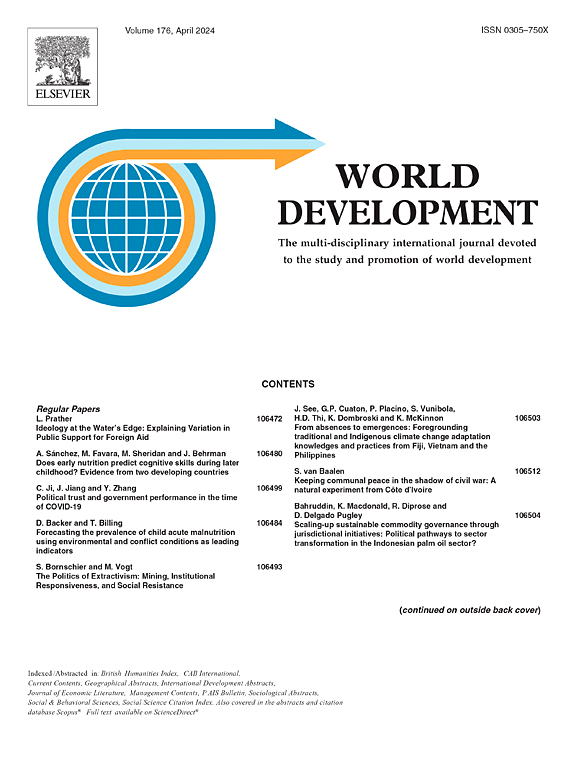脱鞋还是穿鞋?
IF 4.8
1区 经济学
Q1 DEVELOPMENT STUDIES
引用次数: 0
摘要
本文认为,20世纪60年代末赤脚医生项目的制度设计旨在通过强调采集和制备中草药的体力劳动,将农业生产和医疗实践中的脑力劳动与体力劳动结合起来,以解决中国农村医疗保健的成本问题。20世纪70年代初以后,医学学习和实践的特点、工作时间安排、支付方式以及日常实践中西医结合,使得赤脚医生从农业生产和中草药的体力劳动中分离出来。在20世纪70年代中期,1966年至1976年文化大革命期间的意识形态斗争将赤脚医生的体力和脑力劳动解释为对“革命卫生路线”的忠诚和“修正主义卫生路线”的医疗专业化之间的二分法。本文有助于对1949年以前中国农村的医学和公共卫生的比较理解,以及发达国家卫生公平和发展中国家资源短缺的当代全球方法。本文章由计算机程序翻译,如有差异,请以英文原文为准。
Taking off or putting on shoes?: Barefoot doctors, mental-manual labor, and the health revolution in Mao’s China
This paper chronologically analyses three sets of dynamic relationships between mental and manual labor in the institutional design, daily practice, and ideological struggle of the barefoot doctor program in Mao’s China. The article argues that the institutional design of the barefoot doctor program in the late 1960s was aimed at combining mental and manual labor in agricultural production and medical practice by emphasizing the manual labor of collecting and preparing Chinese herbal medicine to address the cost of delivering medicine and health in rural China. After the early 1970s, the features of medical study and practice, work schedules, and payment methods as well as the integration of Chinese and western medicine in daily practice led barefoot doctors to separate from the manual labor of agricultural production and Chinese herbal medicine. In the middle of the 1970s, the ideological struggles during the Cultural Revolution of 1966–76 interpreted the manual and mental labor of barefoot doctors in terms of a dichotomy between loyalty to a “revolutionary health line” and medical specialization in “the revisionist health line.” The dynamic relations between the manual and mental labor of barefoot doctors disclosed the complex features of the health revolution in Mao’s China, including traditional medicine versus modern medicine, deprofessionalization versus professionalization, and political discourse versus distribution practices. This paper contributes to the comparative understanding of medicine and public health in rural China prior to 1949 and to contemporary global approaches to health equity in developed countries and resource shortage in developing countries.
求助全文
通过发布文献求助,成功后即可免费获取论文全文。
去求助
来源期刊

World Development
Multiple-
CiteScore
12.70
自引率
5.80%
发文量
320
期刊介绍:
World Development is a multi-disciplinary monthly journal of development studies. It seeks to explore ways of improving standards of living, and the human condition generally, by examining potential solutions to problems such as: poverty, unemployment, malnutrition, disease, lack of shelter, environmental degradation, inadequate scientific and technological resources, trade and payments imbalances, international debt, gender and ethnic discrimination, militarism and civil conflict, and lack of popular participation in economic and political life. Contributions offer constructive ideas and analysis, and highlight the lessons to be learned from the experiences of different nations, societies, and economies.
 求助内容:
求助内容: 应助结果提醒方式:
应助结果提醒方式:


